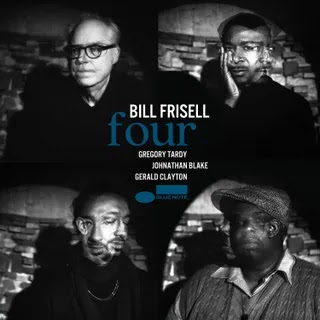On a pair of interlinked albums—one performed with a jazz quintet and the other with a string quartet—the composer-guitarist finds new context for her singular style.
When recounting her origin story, Mary Halvorson often emphasizes a piece of advice she received from two early mentors, Joe Morris and Anthony Braxton: The most important thing is to find your own voice. More than perhaps any other guitarist working today, in jazz or elsewhere, she has succeeded at that deceptively simple aspiration. Hear her play once and you’ll recognize her anywhere: as a soloist, as a leader or accompanist in any number of ensembles, in duos with players from the worlds of avant-garde improvisation or warped indie rock.
On one hand, her tone is clear and declarative near the point of affectlessness, maintaining a sense of calm deliberation even as she spins out increasingly elaborate melodic fractals, stoic in the eye of her own gathering storm. On the other, aided by her trusty Line 6 DL4, she turns the guitar into something slippery and alien. Individual notes seem suddenly to lose their footing, ringing confidently at first, then slipping and wobbling out of tune. Licks pile up on top of each other until they become a single undifferentiated mass, iridescent and oozing out past the margins. When recording, she generally places one microphone on her amp and another directly on her unamplified strings, capturing both sounds at the same time. The effect establishes an unlikely holism between her two approaches to the instrument: bringing out an uncanny quality from the quietude of her clean playing, and grounding her more boisterously outré passages in a certain naturalism.
As a composer and arranger, Halvorson treats each of her albums as an opportunity to create a new context for her singular voice as a guitarist, a practice she continues with Amaryllis and Belladonna, a pair of records released simultaneously and intended as a “modular and interlocking” pair. On Amaryllis, she follows an existing throughline in her catalog toward ever-larger ensembles, leading a newly established quintet—Patricia Brennan on vibraphone, Nick Dunston on bass, Tomas Fujiwara on drums, Jacob Garchik on trombone, and Adam O’Farrill on trumpet—and augmenting the core group with the Mivos string quartet on the album’s second side. On Belladonna, she strips away the jazz band, leaving only her guitar and the strings. By releasing them as separate-but-related projects, Halvorson allows listeners to find their own path through an imposing collection of music: Take each disc on its own, or both together as a double album, in whichever order you choose. I prefer Amaryllis first, then Belladonna, hearing the former as a raucous culmination of Halvorson’s recent bandleader albums, and the latter as a first glimpse of the misty and uncertain territory on the other side.
Amaryllis begins in media res, as if you’ve just wandered into a rehearsal space where Halvorson and the band started jamming an hour ago. Vibes, bass, and drums circle a confounding groove: funky, but with an elusive downbeat, inviting you to dance and then repeatedly pulling the rug out from under you. Halvorson’s guitar joins with a stuttering, asymmetrical line that sounds like a skipping record. Is this the main theme, or just a bit of pointillistic improvisation? Then the horns join her in emphatic unison, and a melody that at first seemed disjointed comes to sound inevitable, even a little triumphant. Halvorson’s compositions often work this way, playfully undermining and deconstructing themselves as they go, unsettling your expectations about what’s a tossed-off thought and what’s the main event.
Halvorson is an inventive and generous arranger, organizing Amaryllis in such a way that it never feels like a mere vehicle for dazzling solos, though there are plenty of those. She has a painterly approach to sonority, attuned to all the rich colors at the ensemble’s disposal. Many of the album’s most beautiful moments come with the dramatic addition or subtraction of a particular instrumental shade, like the way her guitar drapes Garchik’s trombone with gauzy reverb on “Night Shift,” offering an eerily sensuous counterpoint to his brassy declamations. On the title track, guitar and bass charge manically while the horns offer a relaxed countermelody; if it weren’t for Fujiwara’s powerhouse drumming keeping everyone corralled and headed in the same direction, you might think they were playing two different pieces entirely. Later in the same track, strafed on all sides by shards of percussion and mangled guitar, O’Farrill rides a four-note figure up and down the range of his trumpet. The effect is purely analog, but it resembles one of Halvorson’s delay-pedal excursions in the way it turns a stray gesture into a furious idée fixe.
Belladonna removes the buttress of Amaryllis’s horns and rhythm section. At times, the guitar and string quartet move like a single amorphous organism, untethered from any particular pulse. At others, one voice will offer a steady ostinato as a home base for the others to wander away from and return to at will. Melodic lines drift in and out of focus and cohesion. Allow your attention to soften for a while and you may return to find that a figure you’d taken for granted as simple accompaniment has emerged at some point as the music’s central focus. These qualities were all present on Amaryllis but are even more pronounced here, the sparser instrumentation allowing the music to dissolve almost completely before coming together again.
The spectacular “Haunted Head” begins with a three-note line on Halvorson’s low strings. When she adds a couple of higher pitches, the violins immediately take them up too, sounding as one with the guitar, providing her percussive picking with ghostly sustain. These sorts of unison lines are all over both albums, and by now—“Haunted Head” is Belladonna’s penultimate track—we know that Halvorson will likely complicate the simple gesture as the piece goes on. Sure enough, as the figure repeats, the strings slowly grow more dissonant, floating further away from the key the guitar has established. But they remain locked in with its rhythm, preserving the illusion that you’re hearing a single mutating voice, rather than the gradual building of a chord.
For 10 minutes, the piece proceeds in this way, taking a previously established element and elaborating on it unexpectedly, bringing the music someplace new. Halvorson’s initial low-string line eventually becomes the seed of a soaring melody for the entire ensemble, then the cello picks the initial version back up in pizzicato while Halvorson takes a jaunty solo. Music that began as vapor, sparse and spectral, has become a sort of alien parlor dance, joyous and irrepressible. And thanks to the way Halvorson embeds a bit of each previous gesture within the next one, the shift has happened in a way that feels natural, without a single jarring left turn.
Amaryllis and Belladonna are distinct statements; one could hear either album on its own without a sense that something is missing. But they are most powerful when taken together, like a landscape and its reflection in rippling water. The clearest moment of synchronicity between the two comes with a rupture at the end of each: Halvorson clicking on the distortion pedal and starting to burn—finishing with a solo whose intensity far exceeds anything that’s come before, clearing a path toward whatever’s next.

















0 comments:
Post a Comment